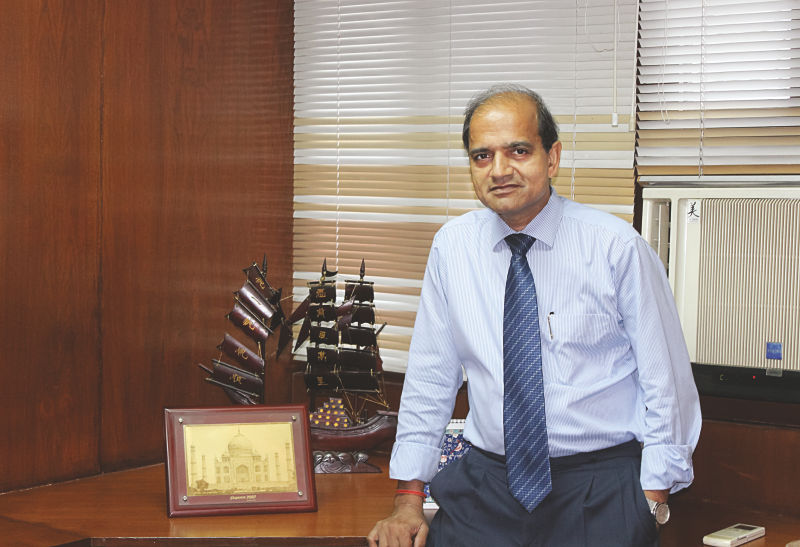JK Paper Ltd has completed the acquisition of Sirpur Paper Mills Limited at a cost of Rs. 371 Cr on August 2, 2018. The acquired mill is to undergo modernization costing another Rs. 350 Cr (approx.) and is slated to commence production within 6 months. The acquisition is going to provide synergistic advantages to JK in terms of strategic location, raw material access, and diversification of its product range. As part of its organic growth model, the company is also setting up a 150,000 tonnes packaging board project with a refurbished pulp mill at its unit CPM, Songadh, Gujarat at a planned cost of Rs. 1450 Cr.
Paper Mart interviewed Mr. A. S. Mehta, President, JK Paper Limited to get apprised on the significant event, i.e. the acquisition and revival of Sirpur Paper Mills. Excerpts:

Paper Mart: Please update us with the developments so far on the acquisition of Sirpur Paper Mills limited.
A.S. Mehta: On August 2, 2018, JK Paper has completed the acquisition of Sirpur paper Mills limited. The acquisition costing Rs 371 Cr will add 1.40 Lac tonnes per annum to the capacity of JK Paper taking it to 6.00 Lac tones per annum. JK is now all set to revive the sick mill.
PM: What is the nature of the takeover? Give us the financial figures related to the acquisition.
ASM: Under the Insolvency and Bankruptcy Code (IBC), this acquisition is a full acquisition and we have control over the mill after paying the agreed amount in the resolution plan, i.e. Rs 371 Cr. Out of total outlay of Rs. 728 Cr for reviving the mill, the resolution plan is of Rs. 371 Cr, and the rest will be invested in modernizing the mill. This includes payments towards settlement of financial creditors, corporate insolvency resolution process cost, admitted operational creditors, workmen and employees.
Out of Rs 371 Cr, Rs 166 Cr has been deposited in the banks as one time cash payment, Rs 43 Cr is the equity capital to the banks, and Rs. 162 Cr is the preference capital issued to banks to be redeemed after 20 years. The entire money was paid on August 2, 2018, and in return, we received the letter of possession on August 2, 2018.
In our resolution plan, you may notice that we have given some equities to the banks too. JK Paper wanted their holding in this company for the sake of relationship continuity.
PM: Tell us the JK’s thought or business strategy behind going for such an acquisition as SPML?
ASM: For the Indian paper industry, this is a phase of consolidation, which is likely to continue for some more years to come, creating a situation where smaller and inefficient units would make way for larger and more efficient units. JK however would not be a part of a consolidation as far as smaller units are concerned as its strength lies in high quality segments such as maplitho, copier, premium packaging board, etc. We target only those units whose volume, product, and quality may fit in these segments and match JK’s standards. If such units are being run inefficiently or are sick, they present suitable opportunities for JK to take over and revive them by infusing efficiency and structured remodeling. JK’s core competence lies in low cost and efficient manufacturing, which it can leverage to create value. Sirpur Paper Mills Limited (SPML) fitted the above bill absolutely and we went ahead to acquire it.
SPML was shut down primarily because of inefficient operations and high raw material cost involved. Besides, some inbuilt inefficiencies and lack of funds were also responsible for rendering the mill unviable. Now, JK is going to run the same unit and hopes to make it financially viable soon. Before Sirpur, JK contemplated on acquiring BILT and Century at different point of times but proposals didn’t fructify. We thereafter earmarked Sirpur. With assured support from the Govt., JK is sure to make a successful turnaround for SPML.
PM: Apart from what you just mentioned, there must be some other tangible factors which made SPML fit for acquisition. What are those?
ASM: Of course, there are! Foremost is the favorable location, a reason for our strong interest in the Sirpur mill. Singareni Coal Mines are very near to the mill which will ensure uninterrupted coal supply at lesser logistics cost. The unit is in close proximity to the raw material belt and the availability of water is also not a concern. The area around SPML is good for plantation and we intend to launch a full-fledged plantation program in the area by next year. For last 5 years, JK’s strategy has been centered on plantations to achieve raw material security. We have fairly succeeded in our plantation efforts and now get sufficient wood from our own catchment. Raw material availability has been an important factor in our profitability. We plan to replicate that success for SPML too.
Besides, Govt.’s incentives and concessions have been a big push for us to consider this acquisition. Without those, making the mill financially viable would have been impossible. If we combine JK’s core competencies with the supportive environment that the Govt. has provided, we are sure of making things work.
PM: How crucial are the govt.’s incentives to JK for facilitating the revival of the mill?
ASM: The incentives and the concessions have been extended by the government with the sole objective that the unit may run with commercial viability. We signed an understanding with the government only after these incentives were agreed upon. These incentives have been extended to the mill for a period of 10 years. In 10 years time, the mill will become self sufficient and will not need any further concessions. The raw material procurement and coal supply are all part of the concessions and benefits given by the government.
PM: How will SPML be accommodated in JK’s corporate structure, as a standalone entity or to be merged in JK as a brand? Once the production starts, how would you market the products, i.e. as SPML products, or JK products?
ASM: Sirpur Paper Mills Ltd will remain as it is for the time being. Sirpur will be held by JK Paper as its subsidiary. As far as branding and sales strategies are concerned, we need to be careful in adopting practices without disturbing the JK brand and quality expected thereunder. Major products of SPML will continue as they were while some may get the JK tag depending on whether they qualify the minimum quality standards of JK. But for that, we first need to assess what quality comes out of the unit once it’s operational. However, as part of the branding strategy, there will be efforts to continue Sirpur brand for most of the products.
There will be full synergy of the sales and marketing between the companies. JK has a well established distribution network, which it intends to leverage fully to sell SPML’s products. We have our own sales setup across the country and Sirpur unit will be using the same.
PM: Tell us something of the corporate synergy expected of this acquisition.
ASM: The first synergy is that SPML is going to get an expansive sales, marketing, and distribution network from JK. This is a great synergy, as far as SPML is concerned, for pushing its products through a well-established channel without incurring any major cost or effort. The second synergy may be in the area of corporate procurement. JK has a well-laid corporate procurement function, which would handle the SPML requirements also.
The other significant synergy is management synergy, which will assist in revamping the overall organizational and operational structure of SPML, where the manufacturing core-competence of JK Paper would be used optimally to drive sustained growth of this unit.
PM: When are we going to see Sirpur up and running? Also, what product grades are we going to expect?
ASM: To my mind, our target is around 5-6 months to commence the production. Sirpur unit used to make varieties of writing-printing paper including maplitho and other special grades, JK will continue with majority of them. SPML was also making packaging and wrapping paper including duplex board; we will resume their production also. In other words, whatever they were producing, we will also produce.
Our maplitho volume will double after supplemented by Sirpur’s production. JK, in its product range, doesn’t have coloured paper, which it would now from Sirpur unit. In ledger paper also, we don’t produce certain varieties and GSM, which we are going to get from the Sirpur unit. Overall, the production from SPML is going to supplement and complement with the existing portfolio of JK Paper very well.
PM: As part of the total outlay meant for reviving SPML, a major amount is going to be channeled into modernizing the mill. Can we have a glimpse of what are you going to do in terms of technological reforms?
ASM: Some of the paper machines will need to be modernized and modified. Since the factory was shut for four years, we need to perform major overhauling and debottlenecking of the machines. The mill’s capacity is 140,000 tonnes per annum, but it has never produced more than 99,000 tonnes per annum. That means there are some inherent issues, which we need to figure out and fix. We intend to remove all such bottlenecks to achieve 100 percent capacity utilization. This will be done in the Phase I of revamp plan.
There are some issues with the efficiency of the power division, which is a critical section in order to provide optimum running efficiency to the mill. This unit was not planned in a way that could lead to energy efficiency. We are going to put a high-efficiency boiler in the mill along with a turbine. We are going to focus much on the power block, so much so that it would become almost new. This is a part of Phase II.
These jobs would be taken up simultaneously with the refurbishing, debottlenecking, and modernization of the paper machines. We are going to build an ECF based fiber line for improved pulp quality with least pollution load. Besides, there would be a new electrostatic precipitator (ESP) and a complete online monitoring system to keep track of and control various environmental variables. The revived mill is going to be environmentally compliant in every respect.
All these things and some others have been taken care of in our CapEx of Rs 350-400 Cr. The major amount of this outlay, however, is going to be spent in installing the high pressure boiler and the new turbine.
PM: Is there any plan for increase in the capacity of SPML, or any other Greenfield expansion plan?
ASM: Our first intent is to utilize 100 percent of SPML and manufacture 140,000 tonnes of various grades of paper. As of now, there is no such plan.
JK will keep growing and increasing its capacity either through acquisition or expansion. Through acquisition (of SPML), we have already added 140,000 tonnes per annum in total capacity. Through expansion, we are going ahead with a packaging board Greenfield project of 150,000 tonnes per annum in Gujarat. In addition to a 150,000 tonne board machine, the facility in Gujarat is going to have a refurbished pulp mill along with captive power plant. The capex for the whole project is planned to the tune of Rs. 1450 Cr. The time period for this project is around 30 months, including environment clearances.


